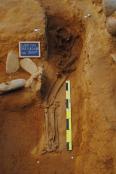CAMPAGNA 2018 |
1° SETTIMANA |
2° SETTIMANA |
3° SETTIMANA |
4° SETTIMANA |
5° SETTIMANA |
6° SETTIMANA |
7° SETTIMANA |
8° SETTIMANA |
9° SETTIMANA |
28 GIUGNO 2018 
Resoconto della giornata di scavo
Area 3000
Nel Settore B è iniziata la rimozione degli individui USK 3889 e USK 3905, all’interno delle fosse sepolcrali US – 3887 e US – 3895. Nella porzione centro-settentrionale è stata completata la messa in luce dell’individuo USK 3885, orientato W-E e deposto in decubito dorsale all’interno della fossa sepolcrale US – 3901. L’inumato, probabilmente un maschio adulto, si presenta complessivamente in cattivo stato di conservazione, con il cranio, in apparizione superiore, molto frammentato, schiacciato verso il basso e ruotato verso nord; la mandibola, invece, risulta in posizione originaria. L’avambraccio sinistro è leggermente flesso sul coxale corrispondente ed è disarticolato dall’omero, che è come spostato verso l’interno del corpo. Gli arti inferiori sono leggermente flessi e ravvicinati, con il femore destro ruotato lateralmente e le caviglie ed i piedi uniti. Si evidenzia un generale slittamento del corpo, in particolare degli arti inferiori, verso sud e verso il centro della tomba, causato probabilmente da effetti tafonomici legati alla decomposizione del corpo in spazio vuoto. Si può infatti ipotizzare che il corpo sia stato originariamente adagiato su una sorta di tavolato ligneo posto sul fondo irregolare della fossa che, una volta decomposto, avrebbe causato lo spostamento di alcune parti del corpo, non ancora completamente scheletrizzate. Alcune assi di legno dovevano essere inoltre presenti anche al di sopra del corpo dell’inumato, isolandolo così dal sedimento circostante.
The 3889 skeleton team removed and wrapped bones and took pictures of the progress through the day. The 3885 skeleton had GIS points taken as well as pictures and the removal of the skeleton began. The 3905 skeleton started the removal of lower limbs. Amy was at GIS lab today. Chloe was in Osteo lab today.
Area 5000
Continua la messa in luce della porzione di area più orientale, a contatto con la struttura muraria USM 4052. Qui è stato esposto un taglio dalla forma irregolare ma che sembra avere delle dimensioni piuttosto grandi. Sarà necessario pulire con più attenzione le zona limitrofe a questa nuova evidenza archeologica per poterne capire la funzione e la natura. Sono inoltre state messe in luce delle fosse dalla forma ellittica tagliate dalla struttura muraria sopra menzionata. Per quanto sia necessario scavarle per poterne determinare la funzione possiamo già supporre che siano altre fosse sepolcrali relative alla fase cimiteriale precedente all'edificazione degli edifici abbaziali di XII secolo già individuata negli scorsi anni di scavo in questa zona del sito.
Today the students in section D continued working in the existing cut. Two areas of discoloration were excavated revealing a tooth in one and bone fragments in the other. The rest of the area revealed multiple bone fragments, a rib, what may be pig bone, a few teeth, and slate. The students in section C excavated 5 cm of topsoil in a cut perpendicular to the trench created on Tuesday. The south side of this cut exposed soil discolorations that indicate additional contexts that appear to predate the wall. In one of these contexts, shards of pottery were found, and tomorrow the entire section will be brought down to better expose this layer. The north side was taken back about 3 meters to the north about 4-5 cm deep. A piece of pottery was found very close to the margin of the trench that was very similar in appearance and style to one found near the margin on the south side of the trench. The soil removed from the north side layer revealed two possible contexts that the wall cut, possibly predating the wall and may be in connection to holes being excavated in section D.
Area 6000
Today we continued removing skeleton 6204. The ribs, clavicles, scapulae, skull and sternum were removed, wrapped and labeled. The cranium below the right femur of skeleton 6214 turned out to be another burial, as there appears to be a spine connected to the posterior portion of the cranium. The fill over this new potential burial has begun to be cleaned in preparation of excavation of the skeleton.
In Area 6215, we found the foot bones of the skeleton and uncovered several hand bones below the pelvis. After exposing most of the skeleton and preparing the site, we took photos of the site and took points using a total station. We then began removing the bones from the reduction portion of the site, such as the pelvis and vertebrae, wrapping them in tarp and labelling them. Underneath the pelvis, we also found a mandible containing a few teeth, which we also removed and wrapped. We have left the connected bones such as the legs and arms in the site for the time being.
Today in area 6015, three students continued working on what is now a confirmed burial due to the lower extremities being in anatomical position. We have measured our area with the total station, and have taken pictures of the uncovered skeletal remains, and have now begun unearthing the bones and placing them in bags for future analysis.
In area 6214, three students filled out the context sheet for the burial including sketching the remains and measuring several of the long bones. We then proceeded to slowly remove the remains, wrap them in cloth and label them. A third pelvis was also found in the fill of burial 6214.












